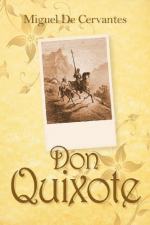|
|
Don Quixote Author/Context
Miguel de Cervantes Saavedra
Born in Alcalá de Hanares, Spain in 1547, Cervantes was one of seven children. His father, a barber-surgeon (performed minor medical procedures such as setting bones and blood-letting) moved the family about constantly. Not much is known regarding his early education, however, it is certain that he never attended university.
In his twenties, Cervantes' life reads like an adventure novel, many aspects of which appear in his book, Don Quijote. After publishing his first poem, he worked for a time as a chamberlain for a cardinal in Rome, then enlisted in the army. Known for his courage, he lost the use of his left hand (in a battle at sea) against the Turks in 1571. On a return voyage to Spain in 1575, he and his brother were captured by Barbary pirates, with Cervantes remaining unransomed until 1580 when his family were finally able to raise the money.
Cervantes spent the rest of his life writing and employed in various civil servant positions; for which he showed no aptitude since his financial documentation often resulted in litigation and even time in prison. He sired one child with a married woman (later gaining custody the child) and eventually married another woman before the age of forty. He was paid well for La Galatea, a pastoral romance (a new popular genre); published in 1585. Cervantes also wrote several plays but was unable to earn enough to make a living solely as a playwright and returned to civil service.
Finally, in 1605 Cervantes' parody on chivalric romance -- The Ingenious Hidalgo Don Quixote of La Mancha was published. Like the romance novels of today, chivalric romances were the most popular published fiction of the day. Cervantes mocks their unrealistic plots, characterizations and plethora of virgins, giants, knights and magicians. The book was an immediate success, with Cervantes following it up with a sequel ten years later; following on the heels of Avellaneda's (pseudonym) illegitimate sequel.
Cervantes died in 1616. Cervantes' Don Quijote is recognized for opening the door to the possibilities of the novel. His deft characterizations and insights into human nature influenced Freud; who claimed that Cervantes led him to make several psychoanalytical discoveries. Don Quijote has been translated into almost every language and after the Bible, is the most widely published book in the world.
Bibliography
Cervantes, Miguel de. Don Quijote. Translated by Burton Raffel. Edited by Diana de Armas Wilson. New York, London: W.W. Norton & Company, 1999.
Nicolás Wey-Gómez. "Anselmo's Eating Disorder". From Don Quijote. Translated by Burton Raffel. Edited by Diana de Armas Wilson. New York, London: W.W. Norton & Company, 1999.
Encyclopedia Britannica Online. "Cervantes Saavedra, Miguel de".
Coloquio: Revista Cultural en Español. "Famous Hispanics: Miguel de Cervantes Saavedra".
Wittman, Sandra. "Cervantes' Man of La Mancha". Oakton Community College.




